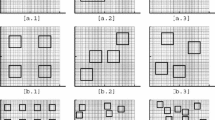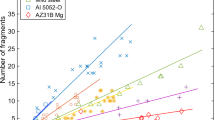Abstract
In this series of papers, we investigate the mechanics and physics of necking and fragmentation in ductile materials. The behavior of ductile metals at strain rates of about 10,000 per second is considered. The expanding ring experiment is used as the vehicle for examining the material behavior in this range of strain rates. In the present paper, the details of the experiment and the experimental observations on Al 6061-O are reported. Specifically, the design of the expanding ring experiment is evaluated through an analysis of the electromagnetic and mechanical aspects of the problem. Then, through an innovative use of high-speed, high-spatial resolution imaging we determine the sequence of deformation and failure in the expanding ring. In particular, the high speed photographs reveal that multiple necks nucleate along the circumference of the ring near a critical strain level; this is followed by a sequence of fractures, and eventually the fragments are unloaded and move as a rigid body. The strain at the onset of localized deformation, the time of fracture initiation, and the sequence of fragmentation are~all quantified in these experiments. These experimental results facilitate detailed comparison to analytical and numerical models of the fragmentation process. Following this, quantitative interpretation of the experimental observations is pursued. First, the uniform expansion of the ring is considered; the observed radial expansion is shown to agree well with an analytical solution of the problem based on a strain-rate-independent plasticity model. The evolution of the strain in the specimen and the onset of necking are evaluated quantitatively and shown to exhibit no dependence on the applied strain rate for this material; the strain at final fracture, averaged over the entire ring, is shown to be an inadequate measure of the ductility of the material. The fragmentation process is modeled with finite element analysis, incorporating the concept of the Mott release waves; this simulation provides a detailed numerical characterization of the experimental observations. Finally, the statistics of the necking and fragmentation are evaluated; these are interpreted both with the predictions of the linear perturbation analysis and a Weibull/Mott model of necking and fragmentation. In the sequel, we will explore the effect of material ductility, strain rate dependence, the effect of geometry and constraint, and finally the effect of a compliant cladding or coating on the development of necking and fragmentation.
Similar content being viewed by others
References
AIP (1972) American Institute of Physics Handbook, 3rd edn. New York
Altynova M, Hu X, Daehn GS (1996) Increased ductility in high velocity electromagnetic ring expansion. Metallurgical Mater Trans A 27A:1837–1844
Becker R (2002) Ring fragmentation predictions using the Gurson model with material stability conditions as failure criteria. Int J Solids Struct 39:3555–3580
Frassengeas C, Molinari A (1994) Fragmentation of rapidly stretching sheets. Eur J Mech–A-Solid 13:251–268
Fyfe IM, Rajendran AM (1980) Dynamic pre-strain and inertia effects on the fracture of metals. J Mech Phys Solids 28:17–26
Gourdin WH (1989) Analysis and assessment of electromagnetic ring expansion as a high-strain-rate test. J Appl Phys 65:411–422
Grady DE, Benson DA (1983) Fragmentation of metal rings by electromagnetic loading. Exp Mech 12:393–400
Grady DE, Olsen M (2003) A statistics and energy based theory of dynamic fragmentation. Int J Impact Eng 29:293–306
Gududru PR, Freund LB (2002) The dynamics of multiple neck formation and fragmentation in high rate extension of ductile materials. Int J Solids Struct 39:5615–5632
Han JB, Tvergaard V (1995) Effect of inertia on the necking behavior of ring specimens under rapid radial expansion. Eur J Mech–A-Solid 14:287–307
Hopkinson B (1910) Collected Scientific Papers, Cambridge University Press
Hopkinson J (1872) Collected Scientific Papers, Cambridge University Press
Jackson JD (1975) Classical Electrodynamics, 2nd edn. Wiley Eastern, 1978
Kipp ME, Grady DE (1985) Dynamic fracture growth and interaction in one dimension. J Mech Phys Solids 33:399–415
Mercier S, Molinari A (2003) Predictions of bifurcation and instabilities during dynamic extension. Int J Solids Struct 40:1995–2016
Mott NF (1947) Fragmentation of shell cases. Proc Roy Soc Lond, Series A 189:300–308
Niordson FI (1965) A unit for testing materials at high strain rates. Exp Mech 5:23–32
Pandolfi A, Krysl P, Ortiz M (1999) Finite element simulation of ring expansion and fragmentation: the capturing of length and time scales through cohesive models of fracture. Int J Frac 95:279–297
Satapathy S, Landen D (2006) Expanding ring experiments to measure high-temperature adiabatic properties. Int J Impact Eng (in press). DOI: 10.1016/j.ijimpeng. 2006.09.085
Shenoy V, Freund LB (1999) Necking bifurcations during high strain rate extension. J Mech Phys Solids 47:2209–2233
Storen S, Rice JR (1975) Localized necking in thin sheets. J Mech Phys Solids 23(6):421–441
Taylor GI (1950) The formation of a blast wave by very intense explosions. II. The atomic explosion of 1945. Proc Roy Soc Lond A201:175–186
Triantafyllidis N, Waldenmyer JR (2004) Onset of necking in electromagnetically formed rings. J Mech Phys Solids 52:2127–2148
von Karman T, Duwez P (1950) The propagation of plastic deformation in solids. J Appl Phys 21:987–994
Zhou F, Molinari JF, Ramesh KT (2006) An elasto-visco-plastic analysis of ductile expanding ring. Int J Impact Eng (in press). DOI: 10.1016/j.ijimpeng.2006.09.070
Author information
Authors and Affiliations
Corresponding author
Rights and permissions
About this article
Cite this article
Zhang, H., Ravi-Chandar, K. On the dynamics of necking and fragmentation – I. Real-time and post-mortem observations in Al 6061-O. Int J Fract 142, 183–217 (2006). https://doi.org/10.1007/s10704-006-9024-7
Received:
Accepted:
Published:
Issue Date:
DOI: https://doi.org/10.1007/s10704-006-9024-7




